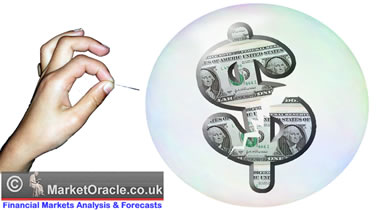Five Major Stock Market Myths Exposed!
Stock-Markets / Stock Markets 2010 Mar 23, 2010 - 02:04 PM GMTBy: Larry_Edelson
 I’ve covered some of the market myths I’m about to tell you about on occasion in the past. And I’ve wanted to consolidate them into a single article for quite some time now.
I’ve covered some of the market myths I’m about to tell you about on occasion in the past. And I’ve wanted to consolidate them into a single article for quite some time now.
But my colleague and internationally-respected analyst Robert Precther beat me to the punch, in an article he recently published for his subscribers.
Fortunately, I know Bob well, and I’m sure he won’t mind if I review the lessons he voices in his article with you, borrowing from his excellent research to help make the arguments. As I’ve often cited in the past, many of these market myths, if not all of them, are critical to your success as an investor.
So let’s get right to what I consider are the top five market myths of all time!
Myth #1: Interest rates are the principal driver behind stock prices.
How many times have you heard that rising interest rates are bad for the stock market, and that declining rates are good for stocks?
If you’re like any average investor, you’ve heard that theory literally hundreds, if not thousands, of times before. Tune into any media show today, and I’m sure you’ll hear it at least once, if not more.
Most stock brokers, and the majority of analysts and newsletter editors, espouse the same causal relationship between interest rates and stock prices.
But the fact of the matter, the plain truth, is that there is no “standard relationship” between interest rates and stock prices. Period.
Consider the last 10 years of market action …
![]() From March 2000 to October 2002, the Federal Funds rate declined from 5.85% to 1.75%, and the Nasdaq plunged 78%.
From March 2000 to October 2002, the Federal Funds rate declined from 5.85% to 1.75%, and the Nasdaq plunged 78%.
Put simply, stocks and interest rates went down together!
![]() From March 2003 to October 2007, the Federal Funds rate rose from 1.25% to 4.75% … and the Dow exploded higher, launching from 7,992 to 13,930 — a 74.2% gain!
From March 2003 to October 2007, the Federal Funds rate rose from 1.25% to 4.75% … and the Dow exploded higher, launching from 7,992 to 13,930 — a 74.2% gain!
In this case, stocks and interest rates went higher together!
Think those are oddball, freak occurrences? Think again …
![]() From August 1929 to July 1932, the Fed’s discount rate fell from 6% to 2.5%, and the Dow industrials plunged a whopping 87%.
From August 1929 to July 1932, the Fed’s discount rate fell from 6% to 2.5%, and the Dow industrials plunged a whopping 87%.
![]() In Japan, from December 1989 to March 2003, the Bank of Japan’s discount rate fell from 4.25% all the way down to 0.10%. And Japan’s Nikkei 225 Index?
In Japan, from December 1989 to March 2003, the Bank of Japan’s discount rate fell from 4.25% all the way down to 0.10%. And Japan’s Nikkei 225 Index?
It plunged from nearly 40,000 in 1989 to 7,824 in March 2003, a loss of 80%.
The fact of the matter is that the relationship between interest rates and stock prices is exactly the opposite of what almost everyone, even the pros, preach: That they are positively correlated, not negatively correlated.
 |
| Contrary to popular belief, there is no standard relationship between interest rates and stock prices. |
A little uncommon wisdom teaches you why. Just think about it for a moment …
When an economy is growing, the demand for money and credit is increasing. Naturally, so is the cost of money.
And in a growing economy, stock prices should also do well. So the two — interest rates and stock prices — should be rising together.
Conversely, when an economy is sliding, the cost of money is also falling, as demand for credit contracts. Makes sense then that stock prices should also be weak, right along with the deflating cost of credit.
Very logical, right? But oh, how so very wrong almost all analysts and investors are when it comes to interest rates and stock prices!
Right now, for instance, almost everyone is telling you that if interest rates go up, that spells the death knell for stocks.
Maybe so, but also, maybe not.
I, for one, think that rising interest rates right now would be bullish for stocks. Reason: It would be symptomatic of demand coming back into the credit markets, of a heartbeat so to speak, and signs of life in the economy. Ergo, that would be a bullish sign for stocks.
Next …
Myth #2: Rising oil and energy prices are bearish for stocks.
Just like the myth about interest rates, we’ve all heard this one before, many times too.
The claim: The increasing cost of energy is a tax on consumers and squeezes corporate profits as well. Therefore, rising energy prices are bearish for stocks.
Makes sense, right?
But consider this: There is no consistent relationship between energy prices and stock prices.
Sometimes energy prices are rising along with stock prices, and sometimes they decline together.
The myth exists simply because the oil crisis of the 1970s still remains fresh in many investors’ minds, and, for those who were too young at the time, because that’s what’s (wrongly) taught to them: That rising oil and energy prices kill stock prices.
The relationship between energy prices and stock prices, if anything at all, historically tends to lean more towards a positive correlation. Like we’ve seen in the last year, for instance …
Since its low in March 2009 at 6,440, the Dow is up more than 65%. Simultaneously, the price of oil rose from a low of $44.58 to today’s $79.61, a 78.5% rise.
Strong demand for energy emanates from an economy that is either doing well, or, is recovering. So shouldn’t that be a positive harbinger for stock prices?
You bet it should. Another market myth exposed!
Myth #3: A widening trade deficit is bad for an economy, and conversely, a narrowing trade deficit is good.
Personally, this is one of my all-time favorites. And truth be told, I used to be guilty of misinterpreting this one as well.
The claim: That a widening trade deficit is terrible for stock prices.
The argument goes like this: A country is importing more than it’s exporting, hence, it’s shipping more capital offshore than it’s bringing onshore. Therefore, domestic stock prices must go down.
Sounds reasonable, doesn’t it? Appeals to the emotions, right?
But history proves that it is entirely wrong, and nothing more than a myth.
Fact: From 1976 to 1998, the U.S. trade deficit ballooned from $6.08 billion to $166.14 billion, and guess what? The Dow Jones Industrials went from 848.63 to 9,343.64!
In truth, the relationship between the trade deficit or surplus and stock prices is exactly the opposite of what the pundits claim.
In other words, a rising trade deficit is related to rising stock prices, and a narrowing trade deficit with recessions and falling stock prices.
Want more proof? Consider what’s happened to the trade deficit since the Dow peaked in July 2007 at 14,239:
The trade deficit narrowed from a deficit of roughly $701 billion to $378 billion, or 46%!
 |
| It’s a myth that trade deficits are bearish for the stock market. |
Myth #4: Corporate earnings drive stock prices.
Another great, giant myth, perhaps even the biggest of them all.
The argument: That if a company’s earnings are rising, the company must be growing, therefore, its coffers must be filling up with cash to pay dividends, or acquire new products or other companies, and good times are here to stay.
So the company’s stock price must go up.
Conversely, if earnings are falling, stock prices must go down.
Well, have you ever seen a company announce better-than-expected earnings, and its share price gets clobbered?
I’m sure you have, probably oodles of times.
Conversely, you’ve also seen plenty of companies announce lower-than-expected earnings, and their share prices move up.
The same thing can happen to the broad markets, taken as a whole.
For example, 1973 to 1975: The combined earnings of the S&P 500 companies rose strongly for six consecutive quarters, yet the S&P 500 Index fell more than 24%.
And according to research conducted by analyst Paul Kedrosky, since 1960, the average annual return on the S&P 500 was greatest when earnings were falling at a clip of 10% or more …
While the smallest returns on the S&P 500 occurred when earnings were growing at up to 10% per annum.
Bottom line: Rising corporate earnings does not guarantee rising stock prices, by any means. Nor does falling corporate earnings guarantee falling stock prices!
 |
| It’s wishful thinking to believe rising corporate earnings will lead to rising stock prices. |
Myth #5: An economy’s GDP drives stock prices.
Most investors and most analysts agree: Stock market prices as a whole, especially in terms of total market capitalization, should reflect a country’s gross domestic product (GDP), the sum total of a country’s overall economic output.
Logical, right?
But consider the following: From the quarter ending June 30, 1976 to the quarter ending March 31, 1980, GDP rose in 15 of 16 quarters. Yet the Dow Industrials fell 22%!
And from April 1, 1980 to September 30, 1980, quarterly GDP contracted, yet the Dow Industrials rose almost 19%!
Direct positive relationship between GDP and broad stock market prices? There is none. Certainly none reliable enough to make investment timing decisions.
Bottom line to the above five major market myths (and more to come in future columns)?
Actually, I have three bottom lines:
1. Never assume anything when it comes to the markets …
2. Question everything, and most of all …
3. Think independently, and exercise uncommon, not common, wisdom!
Stay tuned. There are some major surprises dead ahead in the markets.
Best wishes,
Larry
P.S. Time is running out for major recos! Today is your absolute LAST day to join us while we use a time-honored, scientific approach to build a Rapid Growth Portfolio that not only has huge profit potential, but also will help protect the wealth you’ve already worked so hard to grow. Click here to learn more.
This investment news is brought to you by Uncommon Wisdom. Uncommon Wisdom is a free daily investment newsletter from Weiss Research analysts offering the latest investing news and financial insights for the stock market, precious metals, natural resources, Asian and South American markets. From time to time, the authors of Uncommon Wisdom also cover other topics they feel can contribute to making you healthy, wealthy and wise. To view archives or subscribe, visit http://www.uncommonwisdomdaily.com.
© 2005-2022 http://www.MarketOracle.co.uk - The Market Oracle is a FREE Daily Financial Markets Analysis & Forecasting online publication.



